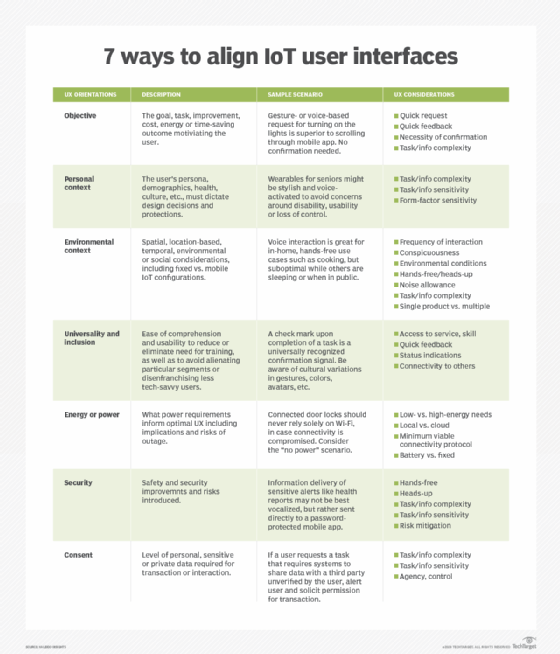
Fotolia
Design IoT user interfaces beyond the screen
IoT technology has expanded into everyday objects and work equipment; yet, it remains largely invisible. This market opportunity brings novel UX challenges for designers.
Sensors, connectivity and product intelligence don't just create new data streams, they unlock a universe of possibilities and potential perils for user experiences and the organizations that design IoT user interfaces.
Ubiquitous sensors, connected devices and networking obscure the fact that digital technology can integrate with just about everything. For decades, screens were the primary user interface for digital technologies and data.
These days, embedded technologies pervade virtually all consumer and worker interfaces, including clothing, cameras, appliances, vehicles and infrastructure. Machine learning and AI techniques unlock an eye-popping array of new interaction modalities, such as voice and emotion recognition, augmented reality, virtual assistants, and robotics.
Good design always requires empathy and user-centricity, but IoT UX design demands more because connected interfaces exist within broader technological systems.
Connected products require a new way of thinking
The conversion from analog to digitally connected products demands a massive shift in mind frame and skill sets. Hardware, software, data, security and user experience fields have all rapidly evolved, and so have the challenges inherent when organizations reconfigure business models to be data-driven and system-defined. Technological advancements expand what digital interaction looks like, what data organizations can collect and how to apply data in unintuitive ways.
Consumers, patients and healthcare providers can use wearables with heartrate variability (HRV) sensors to monitor and determine much more than beats per minute. Doctors and patients can use HRV to infer myriad other health indicators such as physical fitness, digestion, recovery, illness and stress. Software engineers train intelligent cameras, which can power identity authentication, workspace analysis and big data to detect heat or crowds. Organizations have reoptimized these video analytics tools for social distancing analysis and fever and cough detection.
As technology continues to permeate objects and places, organizations risk inundating users with noise, burdening them with clunky mobile apps, and mismanaging their data, safety or trust.
IoT user interfaces evolve business goals and relationships
The strategic starting point for IoT designers and manufacturers is to align product development with business models and user trust to design integrated context.
Alignment with business model. Organizations must reenvision value models away from one-and-done transactions where designers create products less as static endpoints and more as hubs or platforms. Through software updates and integrations, connected products can appreciate over time into new use cases, potential user segments or business partnerships.
Organizations must align core features and functions with a longer-term roadmap and purpose. If the organization intends for the product to act as a gateway to a deeper relationship between stakeholders, it must plan for the ideal end result.
Alignment with users. Human-centric connected product design is not just about aesthetic; it is about minimizing steps between human and objective. Emerging sensors and connectivity ease and enhance that interaction. More options do not equal more intelligence. More bells and whistles do not always mean more value. Botched user experiences can thwart user loyalty, wallet share or, worse, trust.
Although creating simple interactions seems obvious, it is often difficult to preserve when orchestrating software, mobile apps, integrations and human-centric inputs. To guide design decisions, organizations can use seven orientations, or ways of aligning user and product, as shown in the image below. IoT designers and manufacturers can use these orientations as a framework to analyze designs and technologies in order to minimize steps between user and objective and steward data-driven experiences intelligently and responsibly.

These orientations support upstream decision-making in IoT UX, inform sensors, software, interaction formats and GUIs, but they have downstream implications, too. Any engagement strategy requires orchestration spanning multiple devices and channels across dynamic data sets, integrations and APIs.
With new technological capabilities comes greater responsibility
Connected products exist within broader ecosystems -- business, technical and societal -- which increases the design scope. To remain competitive, organizations must envision the role of UX as inextricably linked to any and all interactions between brand and user across teams, customer journeys and the supply chain. Counterintuitively, this involves deemphasizing products and emphasizing the services and partnerships they enable.
Technologically, a competitive vision includes prioritizing interoperability, expanding security topologies, tooling for lifecycle management of data and products and designing for diverse stakeholders.
Societally, connected devices exist within cultures and communities of people and other device networks, which each introduce their own implications for UX enhancement or erosion. Technology raises ethical concerns when it comes to gamification, screen addiction and surveillance.
Integrated products require more than good technological configuration; they require good technological stewardship and balancing business objectives with human empowerment.








